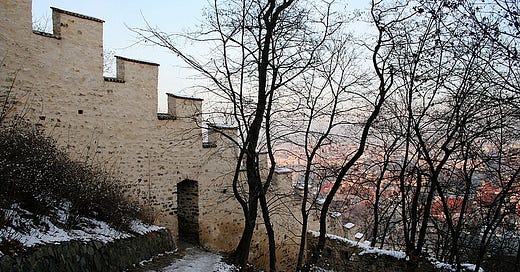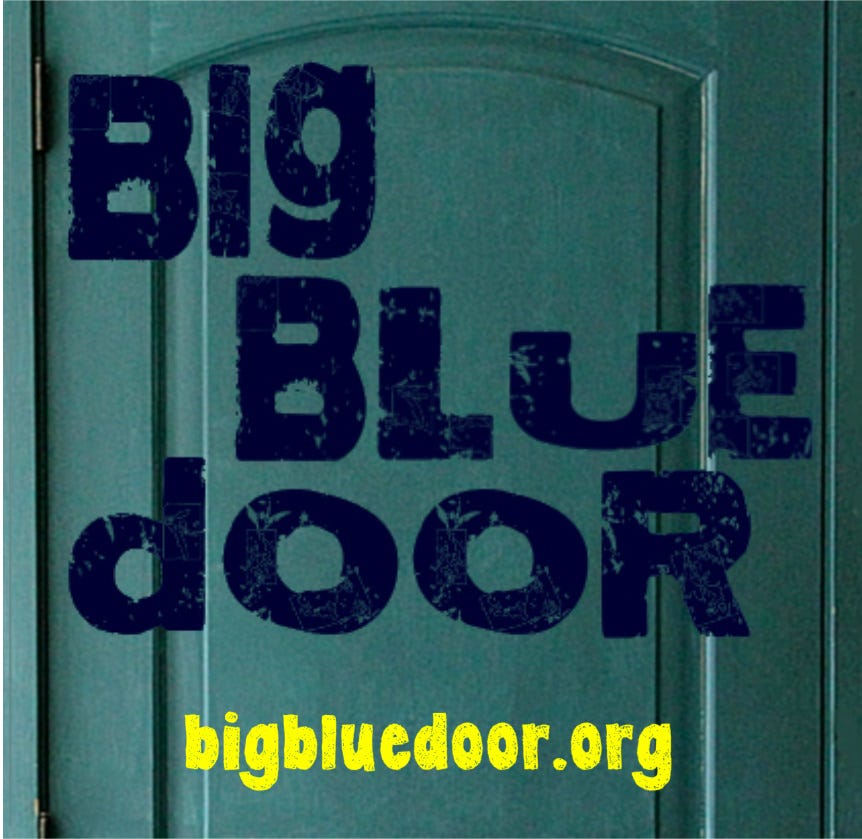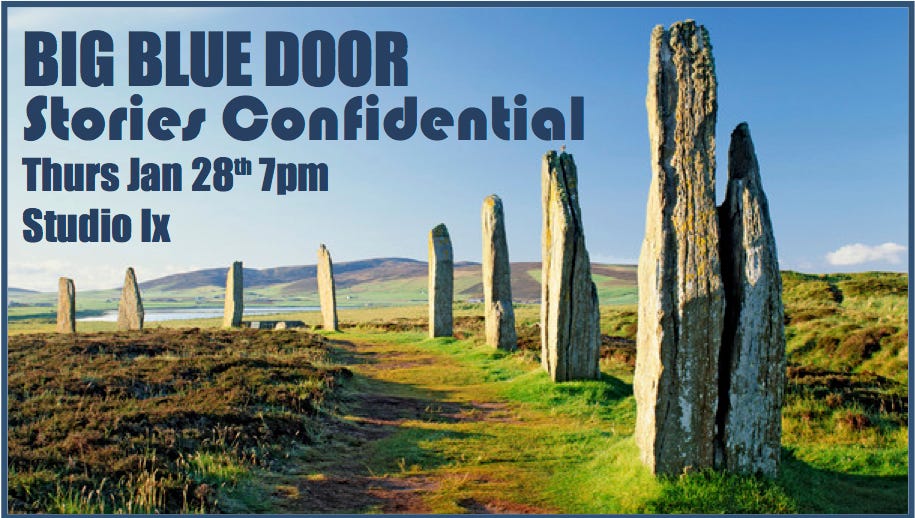Police Stories: The Idea
Part 2 of Welcome to Charlottesville, Blame Cannon's weekly visit to a town, a failed art project, and the future of America.
When Donald Trump was elected in 2016 I thought about Prague.
I’d lived in Prague in 1994 & 1995, teaching English after the fall of Soviet Empire. I loved the city. Charles Bridge at night in the snow, twisting medieval streets, hot klobásas in Wenceslaus Square. And most of all—because I’m a geek—I loved learning about a city and a region I knew little about. The biggest lesson I came away with living in Prague and traveling through the former Eastern Bloc was that in times of chaos cities and towns are on their own.* In fact cities and towns are usually their own. Foreign armies might come to loot, domestic governments always come to tax, but when it comes to jobs, poverty, housing, diseases, disasters, riots, education, and even entertainment, cities and towns aren’t going to get much help. Even when the problems didn’t start with the cities and towns. Most of the current homeless population in downtown Charlottesville today came here from other towns and cities or rural areas. I don’t mean it’s not our problem now; I mean we didn’t cause it.
That’s Life in the Big (and Small) City…
So when Donald Trump was elected in 2016 I believed a lot of chaos was coming and all that New Deal and Great Society national intervention, the agencies and the programs, the night basketball grants and the funding for clean needles would sooner or later come to an end. Maybe not with Trump himself, but sooner or later. And it would be wise to start imagining life for Charlottesville without much outside help.
Then I realized I didn’t know much about Charlottesville. I’m a history buff so I knew about Jefferson and Monroe. And I’d lived here off and on for many years so I’d seen the city’s streets and buildings change, the spread of development up 29 North, a bookstore become a video store and eventually a clothing store, countless movie theaters opening and closing, but in the decades I’d live there I rarely could have said who the mayor way, much less the other city councilors. I wasn’t clear on what a city manager even did. I couldn’t tell you how the roads got paved, the trash picked up, or the sewage piped away. And when I asked around many of the people I talked to confessed they were almost as ignorant as I was.
So I decided to do something about it.
I run a theater company called Big Blue Door.
My wife, daughter, and I moved back here in 2012 to start an improv, storytelling, and theater group called Big Blue Door. At one point we’d experimented with collecting oral histories. It was a fundraiser for the International Rescue Committee and we paired the interviews with a comedy show. Unfortunately, it just didn’t raise much money, so we put it on the back burner to return to someday. Well, 2016 was Someday. After the election I decided to learn more about Charlottesville through oral histories shared with art projects.
Oral Histories
The oral histories were modeled on Work Projects Administration interviews during the Great Depression, plus ideas from a group out of Chicago called Story Corps. The interviewer doesn’t try to gather information like a social scientist, but asks open-ended questions and follows up and redirects to help the subject find and share something meaningful to them.
‘Who is someone who mattered to you growing up?’
‘What do you remember about that person?’
No one has to talk about anything they don’t want to talk about. Happy, sad, proud, funny, scary, embarrassing—all memories are welcome—as long as they’re personal and true. If it’s done right almost everyone finds the process enjoyable and even moving.
So we would conduct oral history interviews with local government departments, and then create engaging art projects based on each.
Maybe we’d interview the water authority, and lead a trek through a water pipe with an improv troupe. Or we’d work with the highway department and have a brake light repair event with a band that made songs out of the histories. Maybe fire fighter interviews would be matched with a parody calendar, pictures of trucks or chili recipes instead of hot shirtless fire fighters. I called the project TrueVille, which I thought was a brilliant name that would ensure success.
Why Police Stories?
I decided to start with the police. Government-wise, police are where the rubber hits the road. Why?
Adults interact with police more directly and more intensely than any other arm of the government.
Also I was a social science major in college and studied police more than other parts of government so the learning curve and research wouldn’t be as steep than, say, how the storm drains work.
Also the police and protests against the police had been in the news a lot, particular after the killings of Eric Garner and Michael Brown, so I thought it would be something the public would be interested in.
Also if we were going to traipse through water pipes or repair brake lights the police would likely show up, and it would be nice to have some friends to talk to. Also, and this is the biggest also, I had an idea for a play constructed from the oral histories that I thought would work best with the police.
I figured we’d do, say, twenty interviews—maybe 3 hours of material—that I’d use to create a script for a 45-to-70-minute play. We’d cast about 6 actors and actresses of different races and ages, roughly broken down statistically like the Charlottesville police department. But dialog would be divvied out by theme and subject matter. Quick multi-character montage sections leading to longer individual break-out stories. We’d invite the police, their families, and members of the community to watch together.
Melissa
The person who almost made this work was Melissa Wender. She had performed as a storyteller in several of our regular shows and had even organized a weekly storytelling meet-up the previous winter for a group show called Stories Confidential. I mentioned the TrueVille idea to her in its earliest stages and by the time Police Stories became the first project we had already committed to working on it together. I was ecstatic to have her on board.
I worked up a template of interview questions, which Melissa and I discussed and tweaked. She practiced and experimented with what equipment she’d use to record the sessions. It was decided she’d meet the subjects out of uniform and away from their workplace so interview subjects could talk about work if they wanted, but we wouldn’t force a work identity.
So Melissa was ready. She made a plan to reach out to the police department and recruit her first subjects. Meanwhile I would raise the money, write the play, and recruit a director, stage manager, and actors from the theater community.
I had created Big Blue Door mostly to teach because I love teaching, and structured the organization so that the classes could pay for everything else. I did this to avoid fundraising. But I’ve worked for plenty of groups that did fundraising, I’d raised a little money for Offstage Theater back in the day, and my wife at one time did a lot of fundraising. So I knew the basics.
The Launch
I announced TrueVille Police Stories on February 7th on Big Blue Door’s website, following up with emails and a Facebook post. I scheduled with a filmmaker friend to do a video for a fundraising platform. I wrote the pitch and I designed a logo (above). I applied to one of the largest regional grants organizations, and to another program run by the Cville and The Bridge PAI, and I reached out to the largest local theater company where I’d worked and taught. Jen and I even registered to attend the 2017 TomTom Festival for ideas and networking. I’d find the money. Definitely.
I’d been part of the downtown art scene for a quarter century, part of Charlottesville for longer, givien my free time and sweat to hundreds of my peers and their dreams. Now I had a dream, I had a purpose, and no matter the obstacles I would pick myself up and keep trying no matter what.
How could we possibly fail?
________________________________
*Prague did okay when I was living there. It had the pre-automobile street grid—apartments mixed with groceries and offices and pubs—so people could get by comfortably without cars; it was a capital of a country so it had government jobs; and it’s medieval buildings hadn’t been flattened during WWII so it had a steady tourist industry. Also the Soviet healthcare systems, while not good, were very affordable. And the subways… those communists sure could build subways.
Thanks for reading Police Stories on Blame Cannon! This is Part 2 of Welcome to Charlottesville (Part I here). New chapters come out every Tuesday. Next Tuesday we’ll poke around the history of the area, Tuesday 7/30 I’ll share the Second Time I moved to Charlottesville, and Tuesday 8/6 we’ll return to the Police Stories project.








